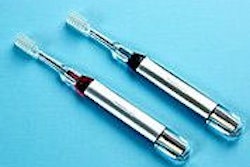
Although both dentistry and anthropology often characterize oral disease risks in behavioral terms, two recent studies indicate that a complex mix of both biological and cultural factors can determine increased risks of caries for women and destructive periodontal disease for men.
For example, does the number of pregnancies (parity) a woman carries in her lifetime influence the number of caries she develops? According to the ADA, some dietary behavioral changes that occur during pregnancy may contribute to caries development, such as increased snacking, decreased oral hygiene, and increased cravings for sugary food.
But John Lukacs, Ph.D., a professor of anthropology at the University of Oregon, believes that more than behavioral factors are at play.
“Gender should be considered in models of risk assessment for periodontitis.”
— Mark A. Reynolds, D.D.S., Ph.D.,
University of Maryland
"Both biological (genetics, hormones, and reproductive history) and anthropological (behavioral) factors such as culture-based division of labor and gender-based dietary preferences play a role," he wrote in a recent Clinical Oral Investigations study (July 21, 2010).
Significant biological factors are at work as well, he said, as seen in the dentition of humans before the advent of processed foods found in postagricultural societies, when caries rates rose even more dramatically than in our hunter-gatherer ancestors.
"Estrogens play a role, but estrogens increase more dramatically with pregnancy, and the cumulative effect of multiple pregnancies has a negative effect on oral health," he told DrBicuspid.com.
Dr. Lukacs pointed to some large, recent studies of adults showing a marked increase in caries and in missing and filled teeth (DMFT, or mean decayed, missing, and filled teeth) in women of child-bearing age, sometimes at a prevalence more than twice that of men.
"As you go through life and look at men's and women's caries rates, they're fairly similar in childhood," he said. "Then in adolescence, where the hormonal difference is greater, women start to depart with a higher caries rate than men. Then when you get into the reproductive years, it gets even more significant. To just base your estimate on teeth that are present could dramatically underestimate the caries rate."
This is especially true with women, as women are more likely to lose teeth to caries, he added.
Dr. Lukacs acknowledges that the evidence linking the number of caries to parity is mixed, but he thinks that it's an oversimplification to attribute the increased number of caries in women solely to their traditional role as the food preparers.
"Anthropologists have underestimated the complexity of the etiology of caries," he said.
Although he has done a great deal of study on the teeth of the prehistoric dentition of the people of India, Dr. Lukacs' contemporary study in India has also pointed to cultural factors, such as dietary restrictions during pregnancy and ritual fasting, which can lead to malnutrition, that compound oral health of women there. Women also have less access to food and dental care in India for cultural reasons (son preference), creating a complex set of etiologies.
Other biological gender differences may be at play as well, he added, such as genetic differences in formation of enamel, salivary flow, variation in dietary preferences, and pathogens of the oral cavity. And it remains unknown how many of these genetic factors are X-linked.
"It's a hard thing to pin down because caries don't form right away," he said.
Men and periodontitis
Another recent study proposes that gender-based differences in immune response contribute to men's increased risk of periodontal disease (Journal of Periodontology, April 28, 2010).
"Males are at greater risk for periodontitis than females," co-author Mark A. Reynolds, D.D.S., Ph.D., chair of the periodontics department at the University of Maryland Dental School, told Dr. Bicuspid.com. "Similar findings in animals suggest that current risk models based on behavioral and environmental factors may not adequately account for sex-related differences in disease experience."
In this study, Dr. Reynolds and his co-author, Harlan Shiau, D.D.S., D.M.Sc., conducted a systematic review of the literature (Medline, Embase, and Scopus) and a meta-analysis to estimate sex-related differences in the prevalence of periodontitis.
From 12 population surveys meeting selection criteria (representing 50,604 subjects), they found that sex exhibited a significant association with prevalence, reflecting a 9% difference between men and women (37.4% versus 28.1%, respectively), although the overall effect of sex in the meta-analysis was comparatively small (d = 0.19, 95 CI: 0.16 and 0.22).
"Overall, the results of this review provide evidence reflecting a higher prevalence of destructive periodontal disease in men compared to women," they concluded.
Even after accounting for factors such as smoking and poor oral hygiene, men may experience more harmful effects from inflammation than women and less protection from microbial pathogens, putting them at higher risk for periodontal disease.
"Gender should be considered in models of risk assessment for periodontitis," Dr. Reynolds advised.
In addition, animal studies both in the wild and in captivity indicate a higher prevalence of destructive periodontal disease among males. Dr. Reynolds proposes that this may be due to their circulating sex hormones modulating the innate and adaptive immune response. He also proposes that some of the "considerable" panel of genes on the X chromosome may underlie differences in immunity.
Men seem to have a more pronounced innate immune response, and women have more pronounced acquired immune response, he said. Men's bodies seem to respond to infection and injury with a more general and nonspecific reaction to the invasion, often marked as inflammation, while women have a pronounced advantage when it comes to acquired immunity, particularly in making antibodies.
"Inflammatory cytokines ... amplify inflammation in response to the bacterial infection, which likely contributes to the [male] risk for periodontal breakdown," Dr. Reynolds said. "Women are generally considered to have a heightened B lymphocyte function, as reflected in antibody production, compared to men, which may offer advantages with respect to protection against infection."
Copyright © 2010 DrBicuspid.com



















